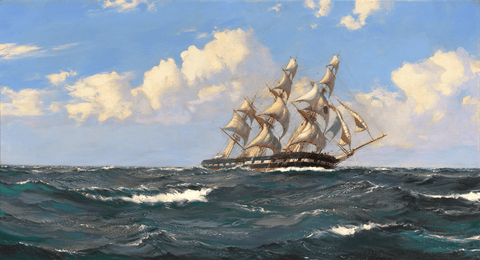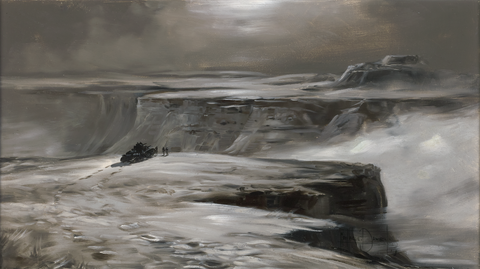Artists & Artisans
Dawson, Montague
Undoubtedly considered the premier marine painter of the 20th century, Montague Dawson is celebrated for his highly detailed compositions of sailing ships and naval battles at sea. He possessed an uncanny ability to capture the motion of the waves, the fullness of the sails, and the atmosphere of the sea in his maritime paintings, which document the great clippers and warships of the 18th and 19th centuries. Lauded as “the King of the Clipper Ship School,” no artist has been able to match the painstaking level of detail and remarkable sense of realism as this maritime master.
EARLY LIFE
One would think that Dawson was born at sea for how well he was able to capture its likeness, but he was actually born in Chiswick, London in 1895. Still, he came to enjoy the thrill of life on the water frequently and at a young age. He was the son of an engineer who was also an avid Thames yachtsman, and Dawson spent many long hours aboard the family cutter.
Thus, it was from his father that he inherited his love of the sea. His passion and talent for art came from his grandfather, Henry Dawson, who was a successful landscape painter. From early in his life, it became obvious that Dawson possessed a talent for drawing, and though he was never formally trained, he embarked on a program of self-instruction that included a study of the Masters. By the time he was just eight years old, he sold his first painting, and by twelve, he won his first art competition, which was run by Boy’s Own Paper.
A CAREER IS BORN
In 1910 at the age of 15, Dawson began his first full-time employment at a commercial art studio in London. There, he was able to hone his skills as a draftsman while working on illustrations for promotional posters. When World War I broke out four years later, he joined the Royal Navy, becoming a naval officer aboard two small ships. The war, however, did not interfere with his artistic ambitions, and Dawson continued to draw.
Due to the exceptional quality of his wartime battle illustrations, Dawson became a regular contributor to The Sphere, a prestigious British newspaper. His ability to capture both detail and drama in just a few expertly drawn lines made his works ideal for the printed page, and in 1918, Dawson earned the largest commission of his career to date when in 1918 The Sphere dedicated an entire issue to his illustrations of the surrender of the German Grand Fleet.
During the war, Dawson also made the acquaintance of an establish marine painter named Charles Napier Hemy. Dawson was deeply impressed by his work, and he became one of the key influences in his career as a painter. Thanks to his encouragement, Dawson took up painting full time after the war.
A RISING STAR
Dawson exhibited his first work at the Royal Academy in 1917; it was a naval subject entitled The Eyes of the Fleet. While he continued to paint military vessels even after the war, his primary interest lay in historical subjects and ships, which he captured with remarkable accuracy.
In 1926, he met the fine art dealers Frost & Reed, who would be instrumental in his future success. Dawson disliked the process of selling his own artwork, and he used his dealers exclusively to sell his marine paintings. Frost & Reed's knowledge of the market and entrepreneurial acumen in many ways contributed to Dawson’s early popularity. By the 1930s, he was already considered a leading marine artist.
In 1934, Dawson and his family moved to Milford on the Sea, where they would live for the rest of their lives. By the time of the Second World War, Dawson refused to move his family from their home, in spite of the fact that their home was now on the front lines of the war. Food supplies stopped coming to the area, and the Dawsons endured a few years of considerable hardship until the end of the war.
While food was scarce during the war, work for Dawson was plentiful. Just as he had during World War I, he regularly contributed his work to The Sphere, and his portrayals of dramatic events at sea became remarkably popular within the war-torn country. Too old to join the Navy, he stayed home in his studio and painted almost non-stop. Officers frequently visited his home, bringing references for his battle portraitures and stories of the horrors of war. Always a perfectionist, Dawson captured the details of their narratives down to the smallest detail in his exceptional paintings and illustrations.
A MARITIME CELEBRITY
By the time the war ended, Dawson was a household name, and he had gained celebrity status in Milford on the Sea. He was both a commercial and critical success, and soon acquired a great deal of wealth that would have allowed him to retire in a life of leisure should he have chosen. However, he remained dedicated to his art, producing new works with an admirable consistency throughout his career.
His popularity became so great that the Mariners' Museum in Rhode Island opened a wing devoted to his works in 1975. Queen Elizabeth II, Presidents Eisenhower and Johnson, and the Sultan of Morocco all owned paintings by Dawson. His yacht paintings were also eagerly acquired by and displayed in the collections of the Vanderbilts and Sopwiths. At the height of his career, it is believed he was the second-highest paid living artist in the world - second only to Pablo Picasso. Following his death in 1973, his works only became more sought after. Today, the work of Montague Dawson is represented in the North Carolina Museum of Art, the National Maritime Museum, Greenwich, the Southampton City Art Gallery and the Royal Naval Museum, Portsmouth, among many others.
Artists & Artisans
Dawson, Montague
Undoubtedly considered the premier marine painter of the 20th century, Montague Dawson is celebrated for his highly detailed compositions of sailing ships and naval battles at sea. He possessed an uncanny ability to capture the motion of the waves, the fullness of the sails, and the atmosphere of the sea in his maritime paintings, which document the great clippers and warships of the 18th and 19th centuries. Lauded as “the King of the Clipper Ship School,” no artist has been able to match the painstaking level of detail and remarkable sense of realism as this maritime master.
EARLY LIFE
One would think that Dawson was born at sea for how well he was able to capture its likeness, but he was actually born in Chiswick, London in 1895. Still, he came to enjoy the thrill of life on the water frequently and at a young age. He was the son of an engineer who was also an avid Thames yachtsman, and Dawson spent many long hours aboard the family cutter.
Thus, it was from his father that he inherited his love of the sea. His passion and talent for art came from his grandfather, Henry Dawson, who was a successful landscape painter. From early in his life, it became obvious that Dawson possessed a talent for drawing, and though he was never formally trained, he embarked on a program of self-instruction that included a study of the Masters. By the time he was just eight years old, he sold his first painting, and by twelve, he won his first art competition, which was run by Boy’s Own Paper.
A CAREER IS BORN
In 1910 at the age of 15, Dawson began his first full-time employment at a commercial art studio in London. There, he was able to hone his skills as a draftsman while working on illustrations for promotional posters. When World War I broke out four years later, he joined the Royal Navy, becoming a naval officer aboard two small ships. The war, however, did not interfere with his artistic ambitions, and Dawson continued to draw.
Due to the exceptional quality of his wartime battle illustrations, Dawson became a regular contributor to The Sphere, a prestigious British newspaper. His ability to capture both detail and drama in just a few expertly drawn lines made his works ideal for the printed page, and in 1918, Dawson earned the largest commission of his career to date when in 1918 The Sphere dedicated an entire issue to his illustrations of the surrender of the German Grand Fleet.
During the war, Dawson also made the acquaintance of an establish marine painter named Charles Napier Hemy. Dawson was deeply impressed by his work, and he became one of the key influences in his career as a painter. Thanks to his encouragement, Dawson took up painting full time after the war.
A RISING STAR
Dawson exhibited his first work at the Royal Academy in 1917; it was a naval subject entitled The Eyes of the Fleet. While he continued to paint military vessels even after the war, his primary interest lay in historical subjects and ships, which he captured with remarkable accuracy.
In 1926, he met the fine art dealers Frost & Reed, who would be instrumental in his future success. Dawson disliked the process of selling his own artwork, and he used his dealers exclusively to sell his marine paintings. Frost & Reed's knowledge of the market and entrepreneurial acumen in many ways contributed to Dawson’s early popularity. By the 1930s, he was already considered a leading marine artist.
In 1934, Dawson and his family moved to Milford on the Sea, where they would live for the rest of their lives. By the time of the Second World War, Dawson refused to move his family from their home, in spite of the fact that their home was now on the front lines of the war. Food supplies stopped coming to the area, and the Dawsons endured a few years of considerable hardship until the end of the war.
While food was scarce during the war, work for Dawson was plentiful. Just as he had during World War I, he regularly contributed his work to The Sphere, and his portrayals of dramatic events at sea became remarkably popular within the war-torn country. Too old to join the Navy, he stayed home in his studio and painted almost non-stop. Officers frequently visited his home, bringing references for his battle portraitures and stories of the horrors of war. Always a perfectionist, Dawson captured the details of their narratives down to the smallest detail in his exceptional paintings and illustrations.
A MARITIME CELEBRITY
By the time the war ended, Dawson was a household name, and he had gained celebrity status in Milford on the Sea. He was both a commercial and critical success, and soon acquired a great deal of wealth that would have allowed him to retire in a life of leisure should he have chosen. However, he remained dedicated to his art, producing new works with an admirable consistency throughout his career.
His popularity became so great that the Mariners' Museum in Rhode Island opened a wing devoted to his works in 1975. Queen Elizabeth II, Presidents Eisenhower and Johnson, and the Sultan of Morocco all owned paintings by Dawson. His yacht paintings were also eagerly acquired by and displayed in the collections of the Vanderbilts and Sopwiths. At the height of his career, it is believed he was the second-highest paid living artist in the world - second only to Pablo Picasso. Following his death in 1973, his works only became more sought after. Today, the work of Montague Dawson is represented in the North Carolina Museum of Art, the National Maritime Museum, Greenwich, the Southampton City Art Gallery and the Royal Naval Museum, Portsmouth, among many others.





